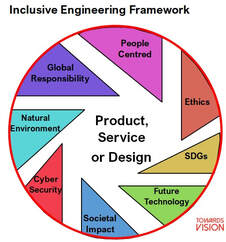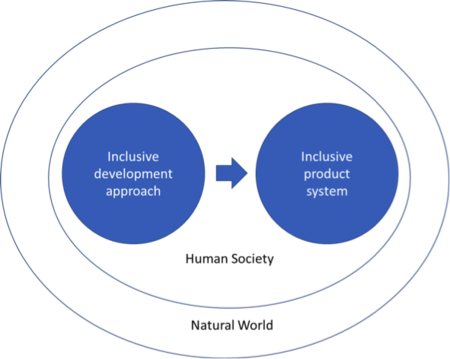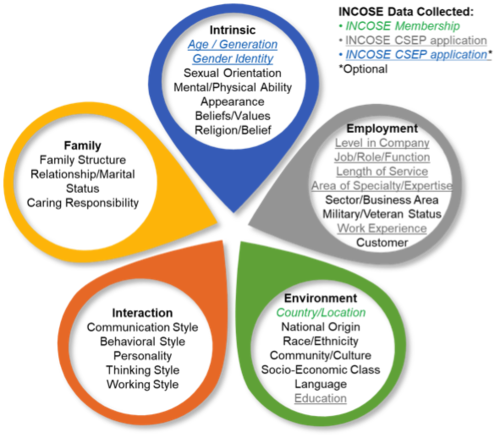Difference between revisions of "Diversity, Equity, and Inclusion"
m (Text replacement - "<center>'''SEBoK v. 2.5, released 15 October 2021'''</center>" to "<center>'''SEBoK v. 2.6, released 13 May 2022'''</center>") |
m (Text replacement - "<center>'''SEBoK v. 2.6, released 13 May 2022'''</center>" to "<center>'''SEBoK v. 2.6, released 20 May 2022'''</center>") |
||
| Line 160: | Line 160: | ||
<center>[[Team Dynamics|< Previous Article]] | [[Enabling Teams|Parent Article]] | [[Technical Leadership in Systems Engineering|Next Article >]]</center> | <center>[[Team Dynamics|< Previous Article]] | [[Enabling Teams|Parent Article]] | [[Technical Leadership in Systems Engineering|Next Article >]]</center> | ||
| − | <center>'''SEBoK v. 2.6, released | + | <center>'''SEBoK v. 2.6, released 20 May 2022'''</center> |
[[Category:Part 5]] | [[Category:Part 5]] | ||
[[Category:Topic]] | [[Category:Topic]] | ||
[[Category:Enabling Teams]] | [[Category:Enabling Teams]] | ||
Revision as of 06:38, 18 May 2022
Lead Authors: Alan Harding, Alice Squires
Diversity, Equity, and Inclusion (DEI) foster increased engagement, productivity, and innovation in an organization.
DEI in Systems Engineering
Systems engineers play a pivotal role in integrating concepts of diversity, equity, and inclusion within the teams they work on and in system design and development. In particular, systems engineers should:
- Ensure that the systems engineering team and its leadership is inclusive and welcomes a diverse range of talent, and where necessary taking deliberate action to provide equity.
- Ensures that the systems we realise are as accommodating as possible of the differences within the entire stakeholder community. This is known as “inclusive engineering”.
Failure to address either aspect can result in sub-optimal outcomes whether in terms of missed solutions, lower productivity, or delivering a system that does not fully meet the needs of the whole stakeholder community, i.e. failing to meet the ultimate goal of delivering a total optimal system solution.
Systems engineers are responsible for effectively communicating the importance and value of diversity, equity, and inclusion in enabling, promoting, and advancing systems engineering and systems approaches to address complex societal and technical global challenges.
Figure 1 shows how an inclusive development approach contributes to realizing inclusive solutions, within the context of the human system (whether within an organisation, country, or the world), itself set within the context of the natural world. The natural world is shown because of the strong linkage between the full lifecycle of engineered products (from concept to disposal) and sustainable development. For instance:
- Water pollution from industrial plants affecting those who live nearby
- Air pollution from cars affecting pedestrians and those who live near major roads
- Product end of life/disposal effects e.g. hazardous substances, contribution to land-fill
Definitions of Diversity, Equity, and Inclusion
The following definitions are taken from the Accreditation Board for Engineering and Technology (ABET 2020), where they provide a reference point for conversations and materials about diversity, equity and inclusion.
- Diversity is the range of human differences, encompassing the characteristics that make one individual or group different from another. Diversity includes, but is not limited to, the following characteristics: race, ethnicity, culture, gender identity and expression, age, national origin, religious beliefs, work sector, physical ability, sexual orientation, socioeconomic status, education, marital status, language, physical appearance, and cognitive differences.
- Equity is the fair treatment, access, opportunity and advancement for all people, achieved by intentional focus on their disparate needs, conditions and abilities. Achieving equity requires understanding of historical and systemic patterns of disparity to address and eliminate barriers, and remove participation gaps as part of a comprehensive strategy to achieve equitable outcomes and social justice.
- Inclusion is the intentional, proactive, and continuing efforts and practices in which all members respect, support, and value others. An inclusive environment provides equitable access to opportunities and resources, empowers everyone to participate equally, and offers respect in words and actions for all.
Commonly, the compound term "Diversity, Equity and Inclusion" (abbreviated to DEI) is used to refer to the broad subject area. The definition of diversity given encompasses a wide range of characteristics. As an example, Figure 2 shows 28 of these characteristics recognised by the International Council on Systems Engineering (INCOSE) (Harding and Pickard 2019) grouped into five areas: intrinsic, employment, environment, interaction, and family. The figure shows the relevance of these characteristics to the INCOSE Systems Engineering Certification Program.
Relevance of Diversity, Equity, and Inclusion to Engineering
Engineers apply ingenuity, innovation, and systematic approaches to solve challenging problems. Life experience and academic research shows us that bringing a wide range of skills, knowledge, and thinking styles to bear on a problem is the most effective way to accelerate and improve the intended outcomes. These outcomes include improved “…financial performance, greater innovation and creativity, increased employee productivity and retention, improved customer or client orientation, and increased customer or client satisfaction.” (Royal Academy of Engineering 2015). Hunt et al. (2018) have found that companies at the forefront of gender and ethnic/cultural diversity in their leadership perform better financially.
By contrast, a team of people with the same cultural background, life experiences, education, and thinking style could be expected to be relatively less effective and more prone to identifying predictable solutions. The US National Academy of Engineering (2002) notes the opportunity cost of a lack of diversity in terms of “designs not thought of, in solutions not produced.”
Inclusion, or ensuring a sense of inclusion in everyone, is necessary to ensure that all team members genuinely feel and believe that they belong and hence are able to use their talents and unique outlook to the maximum degree. By contrast, a lack of inclusion might make someone feel present but not involved or valued with the effect that the team as a whole does not deliver its best possible results.
Equity is not the same as equality, nor is it the same as inequality. It is simply giving more to those who need it, which is proportionate to their own circumstances, in order to ensure that everyone has the same opportunities. In an engineering context this might mean providing more support to a disadvantaged student so they can reach their full potential, or providing additional support or time to a team member with a condition such as dyslexia.
Relevance of Diversity, Equity, and Inclusion to Systems Engineering
DEI is vital to successful systems engineering because of the range of contexts in which it is applied and the consideration of multiple stakeholder viewpoints at the heart of the approach. Systems engineering is applied to a wide range of system types in a broad variety of contexts–engineered systems range from microelectronics to aircraft, from abstract systems to smart cities. Systems engineers may be working with a customer, a prime contractor or integrator, a supplier or product manufacturer, a research/technology organisation, or a government body. And these activities take place all over the globe, often as part of consortiums or complex partnered programmes involving multiple organisations, countries, and cultures.
Applying systems engineering requires consideration of multiple viewpoints (such as the user, maintenance, safety, security) to achieve the proper holistic view of problem and solution. This means that the systems engineering team must be able to understand and work with a wide range of stakeholders. The transdisciplinary and integrative nature of systems engineering across other disciplines and activities, again, means that the systems engineering team needs to understand and work well with all the disciplines and specialities involved in realising a system (INCOSE 2020).
Given this diversity of context and of types of systems engineered, and the wide range of stakeholders with whom they need to work, systems engineering workforce and culture should be at the forefront of DEI. In this way, we can represent as many aspects of the diverse community and their needs as possible within the team, and the diverse nature of the team also creates the innovation from which we can realise the best solutions.
Like most of engineering, systems engineering was historically not practiced by a diverse group of people. Therefore, it is necessary to apply the notions of equity (as defined) in order to ensure that the widest range of people are enabled and empowered to become and develop as systems engineers.
Inclusion (as defined) is about ensuring that the whole (diverse) team is engaged, supported and feels safe and able to give of their best to the team’s activity. An inclusive team will produce increased productivity and better-quality outcomes than the alternative. It also provides increased potential for inclusive products because of the greater range of stakeholder views within the team.
Inclusive Engineering
Inclusive Engineering (Inclusive Engineering, n.d.) is the discipline of ensuring that engineering products and services are accessible to and inclusive of all users and are as free as possible from discrimination and bias. This should consider as far as possible all human differences (characteristics of diversity). It is a way of ensuring that engineering is appropriate, ethical, accessible, and as risk free as possible. The extent to which an engineered system is inclusive reduces the degree to which adaptation has to be applied to address the needs of people with differences e.g., differing vision, differing strength or motor functions.
In their enthusiasm for solutions engineers often do not stop to think about whether they have considered all of the things that impact on their design – and in particular all of the non-technical requirements that are not specified by the client or potential beneficiary. As a result, proposed solutions often lack the perspectives of people who have not been involved in their development – and in an industry which is notoriously lacking in diversity – this often means that they fail to include the perspectives of women, people with disabilities, the ageing population, and those with other under-represented characteristics.
Figure 3 shows an inclusive engineering framework (ref. 8) which has eight elements, all of which are important factors for systems engineers to address even if the stated requirements do not cover them.

One way that systems engineers can maximise the potential for inclusive and sustainable solutions is to ensure that DEI considerations are through application of the ISO/IEC/IEEE 15288:2015 Technical Processes. Table 1 illustrates the application of Inclusive Engineering these processes.
| ISO/IEC/IEEE 15288:2015 Technical Process | Inclusive Engineering considerations |
|---|---|
| Business or Mission Analysis |
|
| Stakeholder Needs and Requirements Definition |
|
| System Requirements Definition |
|
| Architecture Definition |
|
| Design Definition |
|
| System Analysis |
|
| Implementation |
|
| Integration |
|
| Verification |
|
| Transition |
|
| Validation |
|
| Operations |
|
| Maintenance |
|
| Disposal |
|
References
Works Cited
ABET. 2020. "Diversity, equity, and inclusion." Accreditation Board for Engineering and Technology (ABET). Available: https://www.abet.org/about-abet/diversity-equity-and-inclusion/. Accessed December 31, 2020.
Bonfield, D. 2020. "Inclusive engineering framework." Inclusive Engineering. Available: http://www.inceng.org/inclusive-engineering-framework.html. Accessed December 31, 2020.
Harding, A. and A. Pickard. "Towards a more diverse INCOSE." INCOSE INSIGHT Practitioner Magazine. 22(3). Oct 2019.
Hunt, V., S. Prince, S. Dixon-Fyle, and L. Yee. 2018. “Delivering Through Diversity.” Report, McKinsey & Company. https://www.mckinsey.com/~/media/McKinsey/Business%20Functions/Organization/Our%20Insights/Delivering%20through%20diversity/Delivering-through-diversity_full-report.ashx
INCOSE. 2020. "Definition of systems engineering." https://www.incose.org/about-systems-engineering/about-systems-engineering Accessed 31 Dec 2020.
Inclusive Engineering. n.d. "Inclusive engineering." Available: http://www.inceng.org/. Accessed December 31, 2020.
National Academy of Engineering. 2002. "Diversity in Engineering: Managing the Workforce of the Future." Washington, DC: The National Academies Press. https://doi.org/10.17226/10377
Royal Academy of Engineering. 2015. “Increasing Diversity and Inclusion in Engineering–A Case Study Toolkit.” Case study, Royal Academy of Engineering. https://www.raeng.org.uk/policy/diversity-in-engineering/diversity-inclusion-toolkit-re-sources/documents/increasing-diversity-and-inclusion-in-engi-neering.
Primary References
None.
Additional References
None.

